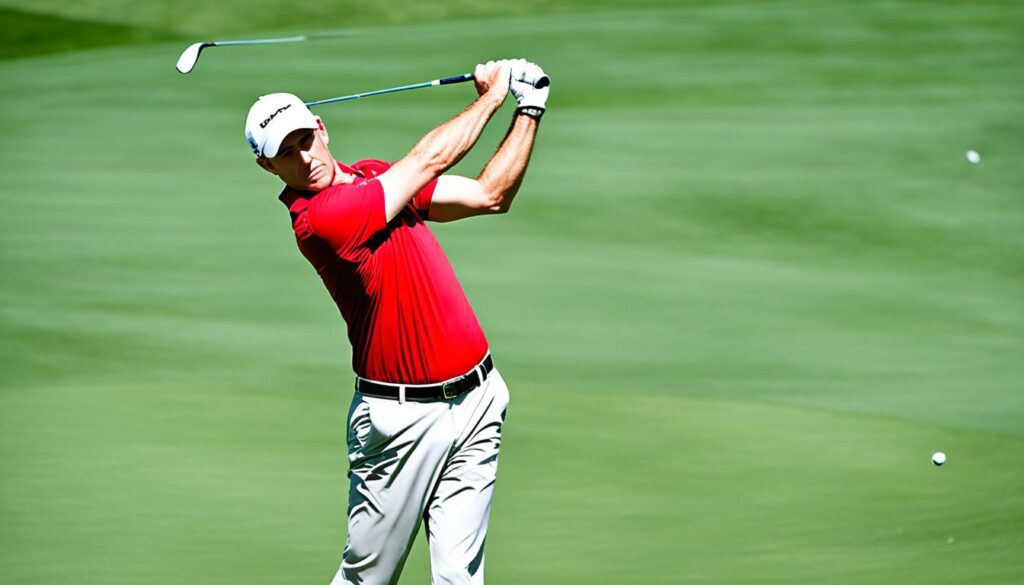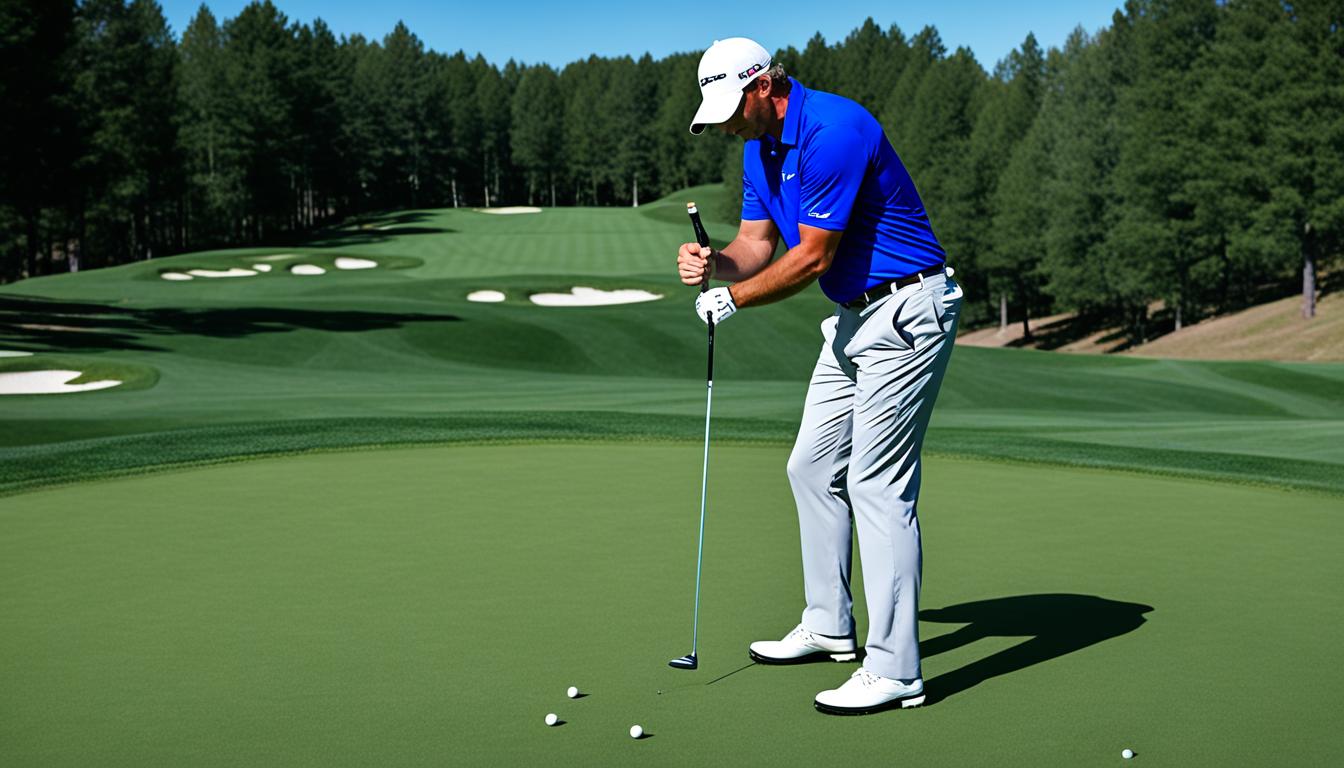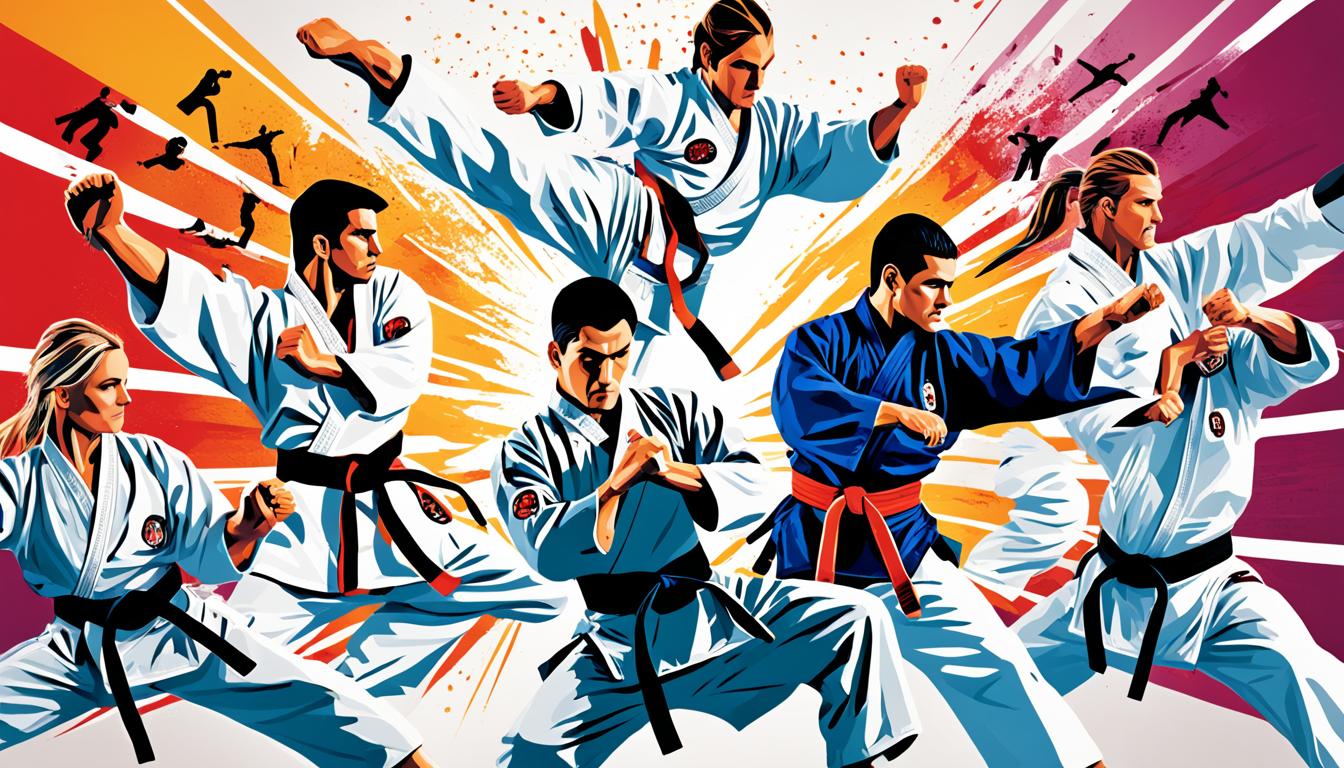Welcome to our in-depth guide on mastering the perfect golf swing. This guide is for beginners wanting to learn the right technique and seasoned golfers aiming to better their skills. It offers knowledge and tips to improve your swing and upgrade your game.
We’ll cover the basics of grip, swing planes, posture, alignment, ball position, and swing phases. By focusing on these essential elements, you can get a consistent and powerful swing. This will boost your distance and precision on the golf course.
Key Takeaways:
- Developing a proper grip is fundamental to a perfect golf swing.
- Understanding swing planes will help you achieve consistency in your swing.
- Maintaining proper posture and alignment is essential for a solid swing.
- Knowing the correct ball position for each club will enhance your impact and launch conditions.
- Mastering the different phases of the golf swing will lead to a more powerful and consistent swing.
Proper Grip: The Foundation of a Perfect Golf Swing.
Having the right grip on your golf club is vital for a perfect swing. It sets the stage for every other part of your swing. It decides how well you control the club and your power and accuracy. Let’s look at what makes a grip good and why it’s key to swinging well.
The Importance of a Correct Grip
A bad grip can mess up your swing in many ways. It changes how the clubface hits the ball and affects the clubhead’s path and speed. Getting the grip right is the first step to swinging consistently and powerfully.
Different Grip Sizes and Strengths
Grip sizes and how strong you hold the club can change your swing. There are three main types of grip strength: neutral, strong, and weak. Let’s dive into each of them:
- Neutral Grip: This grip is the most popular. The “V” made by your thumb and index finger should be on the grip’s center or just right of it if you’re right-handed. It helps keep the clubface straight at the ball’s impact.
- Strong Grip: For a strong grip, shift both hands slightly right on the grip (left if you’re left-handed). This can help close the clubface when it hits the ball, which is good if you often slice the ball.
- Weak Grip: By tilting both hands a bit left on the grip (right for lefties), you get a weak grip. This might open the clubface at impact, useful if you’re trying to avoid hooking the ball.
Maintaining Consistency and Power
A proper grip lets you hit the ball squarely and add power to your swing. By placing your hands right on the grip and keeping a comfy grip pressure, you’ll get the right wrist bend and snap. This makes your swing more powerful.
A right grip is the base of a great swing. It helps control the club and up your power and precision. By knowing the different grips, you can adjust yours to fit your swing style and goals.
| Grip Type | Characteristics |
|---|---|
| Neutral Grip | Positioned for square impact |
| Strong Grip | Can reduce slices, promote closed clubface |
| Weak Grip | Can counteract hooks, an open clubface |
To swing perfectly, start with the grip. Practice with different grips to see what helps your swing the most. A solid grip foundation leads to consistent and powerful swings.
Understanding Golf Swing Planes and Their Impact on Your Game.
To get better at golf, it’s important to know how your swing works. A big part of your swing is the golf swing planes. Knowing about different swing planes helps you adjust your swing. This leads to more consistency and power.
The golf swing plane is the path your clubhead follows when you swing. There are two main kinds: one-plane and two-plane swing.
The one-plane swing
In a one-plane swing, the club stands more upright and the swing path is flatter. This swing moves more in a rotation, with arms and body working together. Golfers who like a more connected swing often choose the one-plane method.
One-plane swing advantages are:
- Consistency: It gives you a swing that’s more repeatable, improving how you strike the ball.
- Power: This swing’s rotation increases the speed and power of the clubhead at impact.
- Simplicity: The one-plane swing has fewer moving parts, making it easier to do and keep up.
The two-plane swing
The two-plane swing has a steeper path and more arm and body separation. It’s linked to more traditional golf swings and has its benefits.
The advantages of a two-plane swing are:
- Accuracy: Its steeper path leads to better control and precision when hitting the ball.
- Power: While it’s more complex, the two-plane swing can still produce a lot of power and distance if done right.
- Versatility: This swing lets you shape your shots more, which is good for golfers who like to control the ball’s flight.
Knowing about swing planes helps you choose the right swing for you. Your body type, flexibility, and what you like can affect your choice. Trying both swings with a coach’s help can show you which suits you best.
Improving your golf swing isn’t just about swing planes. It involves your grip, posture, and alignment too. Understanding swing mechanics and practising regularly can help you create a better swing. This will improve your overall game.
Refining Posture and Alignment for a Solid Swing.
Perfecting your golf swing starts with the right posture and alignment. A strong, balanced setup is key for a solid, consistent swing. We’ll show you how to get into the best position for power and control.
The Importance of Proper Posture
A comfortable, relaxed stance is vital for your swing. Stand tall, and bend your knees slightly for stability. Keep your back straight to maintain balance and support your swing mechanics.
Keeping your spine neutral allows natural rotation during the swing. This boosts power and accuracy. Don’t over-arch or round your back; it hurts your balance and consistency.
Aligning Your Feet and Shoulders
Correct feet and shoulder alignment prepare you for a good swing. Place your feet parallel to the target, aligning your shoulders too. This setup leads to an effective takeaway and a consistent swing plane.
Your feet and shoulders should match the target line for straight shots. For curved shots, adjust as needed. Try different alignments to see what works best.
Finding Balance and Comfort
Balance is crucial for a strong swing. Spread your weight evenly across your feet to prevent leaning. A balanced stance makes energy transfer more efficient and controls the swing.
Comfort in your stance is as important as balance. Adjust your foot width and spacing for a natural, easy swing. Comfort brings consistency, and consistent players succeed on the course.
Understanding the need for good posture and alignment is one thing. Practice and tweaking your stance can greatly improve your swing. Small changes can make a big impact. Build a strong foundation for the perfect swing.
| Benefits of Proper Posture and Alignment | Do’s | Don’ts |
|---|---|---|
| Promotes a natural rotation and coil | Stand tall with a slight knee bend | Avoid slouching or rounding the back |
| Establishes a stable and balanced base | Align your feet parallel to the target line | Excessive arching or leaning to one side |
| Enhances weight transfer and energy transfer | Maintain a square alignment with your shoulders | Excessive leaning or favouring of one side |
| Improves swing consistency and accuracy | Find a comfortable and balanced stance | Ignore the importance of balance and comfort |
Ball Position: Finding the Sweet Spot for Every Club.
Getting the ball position right is key to a good golf swing. It changes with each club, from drivers to wedges. Knowing the right spot for each club helps you hit further and more accurately.
Keeping the ball slightly forward of center for most clubs is best. This positioning helps the ball go farther and higher into the air.
Different clubs mean different ball positions. Let’s look at what works best for each type:
1. Driver:
The driver gives you the most distance. For the best launch, place the ball near your left heel if you’re right-handed. This helps you hit the ball as you swing up, sending it far with low spin.
2. Fairway Woods and Hybrids:
Place fairway woods and hybrids a bit ahead in your stance, near your left armpit. This position helps you hit the ball with a slight upward strike, giving you more control and consistency.
3. Irons:
For mid-irons like the 6-iron and 7-iron, the ball should be in the middle of your stance. This allows for consistent strikes.
With short irons and wedges, move the ball a bit back towards your right foot if you’re right-handed. This positioning helps with better shot control and spin.
4. Wedges:
For wedges, move the ball slightly further back than for short irons. This creates a steeper hit, giving you more control and spin. Feel free to adjust based on the specific shot you’re making.
Practice makes perfect. Keep an eye on your shots and adjust the ball position as needed to improve your swing.
Check out the example below for a visual guide on recommended ball positions:
| Club | Ball Position |
|---|---|
| Driver | Just inside the left heel (for right-handed players) |
| Fairway Woods and Hybrids | Aligned with the left armpit |
| Mid-Irons (6-iron and 7-iron) | In line with the center of your stance |
| Short Irons (8-iron, 9-iron, and pitching wedge) | Slightly back towards the right foot (for right-handed players) |
| Wedges | Slightly further back compared to short irons |
The Phases of the Golf Swing: Backswing, Transition, Downswing, and Impact.
To better your golf swing, it’s key to know and master its phases. By working on the right technique and moves in each phase, your swing will get more consistent and powerful. Let’s look at each phase and offer tips for better performance.
Backswing
The backswing starts your swing and lays its foundation. It involves turning your shoulders, shifting your weight, and making a wide arc with the club. Keep your motion smooth and control your wrists to stay neutral during the backswing. This helps with power and accuracy in the next phase.
Transition
In the transition phase, you move from the backswing to the downswing. You should smoothly shift your weight from the back foot to the front foot and start moving the club down. Keeping this transition balanced and controlled is crucial, as sudden moves can mess up your swing.
Downswing
The downswing generates your swing’s power and speed. It involves movements that bring the club down toward the ball, creating a lag. Engage your lower body by rotating your hips and shifting your weight forward. This generates the needed power for a square impact with the ball.
Impact
The impact is when the clubface hits the ball. Keep a steady and solid stance during this phase, with firm wrists and proper body alignment. This ensures a clean hit and the best energy transfer from the club to the ball. Aim to maintain a forward posture and let the club release naturally through impact.
By mastering each golf swing phase, you can improve your game on the course. Practice makes perfect, helping you develop good habits and muscle memory. Keep analyzing your swing and pay attention to mechanics for a more consistent and powerful swing.
Common Mistakes During Phases of the Golf Swing
| Phase | Common Mistakes |
|---|---|
| Backswing | Poor shoulder rotation, excessive wrist movement |
| Transition | Abrupt weight shift, lack of synchronization |
| Downswing | Overuse of arms, early casting of the club |
| Impact | Lack of forward lean, weak hand position |
Fine-Tuning Your Swing with Practice and Focus.
To perfect your golf swing, it takes more than knowing the technique. Dedicated practice and focusing on details are crucial. This section gives tips for practising well and using golf swing drills and analysis in your training. By doing these regularly, your swing will get better, and so will your performance on the golf course.
Incorporating Golf Swing Drills
Drills are key to improving your golf swing. They build muscle memory, improve technique, and fix swing flaws. Here are some golf swing drills for your practice:
- The Mirror Drill: Practice your swing in front of a mirror to check your posture, alignment, and swing plane. Seeing yourself swing helps make necessary changes for a smoother swing.
- The Impact Bag Drill: Hit an impact bag or stack of pillows to feel the swing’s impact moment. This teaches you how to hit powerfully and keep a strong impact position for better ball striking.
- The Alignment Stick Drill: Use an alignment stick or club on the ground as a target line. Swing along this line to work on your swing path and keep everything aligned.
Being consistent with these drills is important. Do them often to greatly improve your swing mechanics and golf game.
Utilizing Golf Swing Analysis
Using swing analysis tools and tech is vital for enhancing your golf swing. It offers insights into your swing, shows what needs work, and helps track progress. Here’s how to add swing analysis to your practice:
- Video Analysis: Record your swing from various angles with a smartphone or camera. Watch the video to spot issues like bad sequencing or weight problems. Adjust based on what you see and compare swings to note improvements.
- Launch Monitors: Launch monitors provide important swing data like clubhead speed and launch angle. Using this info can refine your swing for better distance, accuracy, and consistency.
With swing analysis in your training, you’ll better understand your swing and make improvements that fit you.

Remember, focus and intention in practice are vital. Keep a positive mindset, be patient, and use what you learn. Spend time improving your swing with these methods, and you’ll surely progress and enhance your golf game.
| Golf Swing Drills | Golf Swing Analysis |
|---|---|
| The Mirror Drill | Video Analysis |
| The Impact Bag Drill | Launch Monitors |
| The Alignment Stick Drill |
Conclusion
To get the perfect golf swing, you must be devoted and practice a lot. Focus on basics like the grip, swing directions, how you stand, where you aim, and where the ball is. Also, pay attention to each part of the swing. This will really up your game and improve how you swing.
Hard work and paying attention to little things will make you better on the golf course. Always hold the club right, know why swing directions are important, keep your posture and aim sharp, place the ball just right, and master every swing phase.
Adding these techniques to your practice will make your swing stronger and more reliable. Remember, getting the perfect swing is a long road. It takes patience and hard work. But, with time and effort, you’ll get better at golf and see the success you’re after.
FAQ
What is the first step in achieving a perfect golf swing?
Start by getting the right grip on your golf club. The right grip helps you hit the ball correctly. It also keeps your swing powerful and consistent.
What are the different grip sizes and strengths?
Grips come in neutral, strong, and weak sizes and strengths. Each type suits different players. It depends on your swing style and what feels best for you.
How do swing planes affect my golf swing?
Swing planes are crucial to your swing. Knowing about one-plane and two-plane swings boosts your consistency and power.
What should I focus on regarding posture and alignment?
Good posture and alignment are key. They help your swing by keeping a strong, balanced stance. Make sure your knees, feet, and shoulders are properly aligned.
How does ball position impact my golf swing?
The position of the ball is very important. It changes with each club you use. Learning the right position for each club increases your accuracy and range.
What are the different phases of the golf swing?
The golf swing has several parts: the backswing, transition, downswing, and impact. Getting each part right makes your swing consistent and strong.
How can I improve my golf swing through practice?
Practice smart to get better at your swing. Using drills and checking your swing helps you focus on what to improve. This will make your swing better over time.





